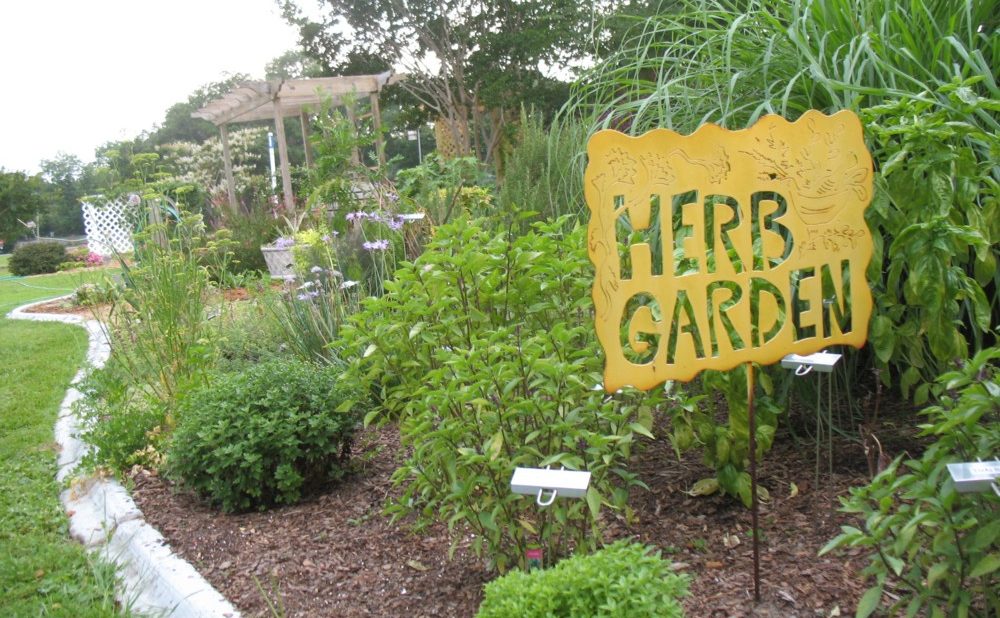
by Roy Carter | May 12, 2015
Herbs are plants that are grown for the special flavor and aroma of their various parts. They are used mainly to season, enrich, or otherwise improve the taste or smell of certain foods. Since they are not classified as vegetables. Since their growth habits and cultural requirements are similar, herbs are often included with vegetables in the garden.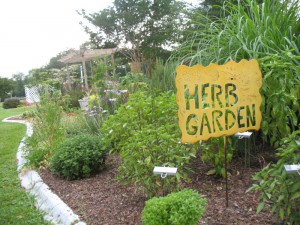
One of the best ways to enjoy year round gardening is to plant an herb garden. Herbs are easy to grow, they require very little care, and they don’t take up much room. Even if you don’t have a large backyard, you can still grow herbs successfully. A small garden bed, a window box, or even a few clay pots, can provide you with fresh, aromatic herbs year round. Herbs are rapid growers and they have a wide variety of uses in the home. They can be used either fresh or dried and when dried they’ll keep for long periods of time.
Herbs are fairly easy to grow. A good garden soil that’s free of weeds and close to a water supply will keep your herbs healthy and growing rapidly. If you can, plant herbs on a narrow strip of land, preferably at the border of your vegetable garden. This will keep your herbs easy to reach. If you scatter them across a wide garden plot, you’ll end up having to walk over the plants to reach and gather them unless you can provide some pathways within your garden. Of course, if you’re growing herbs in window boxes or clay pots, this won’t be a problem.
Dill is probably the easiest and the hardiest herb you can grow. It’s usually planted in late fall and early winter because of its ability to withstand cool temperatures. It may also be planted in the spring. Dill isn’t particularly fussy about its soil so any all-purpose soil that’s suitable for your regular garden vegetables is fine for dill. Another plus is that dill is rarely bothered by any diseases or insects. Fresh dill leaves add excellent flavor to salads and cream sauces, and as a dried herb, dill is well known for the distinct flavor it gives to pickles.
Another popular herb enjoyed by gardeners is sweet basil. This herb is an annual, and it can be replanted in the same area year after year. Basil is also used both fresh and dried. It is widely used as a flavoring for soups, meats and fish. One word of caution: don’t over plant this one. A few basil plants will usually provide more leaves and flowers than an entire family can use in a year.
A few plants, such as sage, balm, and rosemary can be propagated best by cutting. Stems from new growth or the upper parts of older stem make the best cutting for easiest rooting. Cut the stem into 3 to 4 inch pieces each containing a set of leaves or leaf buds near the upper end. To prevent wilting place the cutting in water as soon as they are removed from the plant. A shallow box filled with 4 to 5 inches of a mixture of clean sand, peat, and perlite makes a good root bed. Insert the cutting to a depth of one half-to two thirds their length in the moist mixture; then saturate the mix with water. Place the box in a protected place and keep moist (but not sopping wet) continuously until roots develop in about two weeks. Continue to water until the cuttings are ready to set out in pots or in the garden.
Such plants as thyme, winter savory and marjoram can be propagated by simple layering, which consist of covering the lower portion of the side branches with soil, leaving much of the top of the plant exposed. When the covered part of the stem have rooted, they can be cut from the parent plant and set as individual plants.
Older plants of chive, rosemary and tarragon can be multiplied by dividing the crown clumps into separate parts. These divisions can be set as individual plants.
Mint spreads rapidly by means of surface or underground runners that may grow several feet from the parent plant. The runners, with roots attached, can be removed and transplanted to other locations
Obviously, the list of herbs which grow very well in Florida is quite lengthy, so we won’t be able to go into all of them here. If you can keep in mind just a few points about herb gardens, maybe you can enjoy the virtues of some of these herbs yourself. Remember that herbs are generally very easy to grow and can be adapted to either outdoor garden or indoor container growing conditions. For just a small amount of effort, growing herbs can provide you with year-round gardening satisfaction.
For more information see UF/IFAS Gardening Solutions.
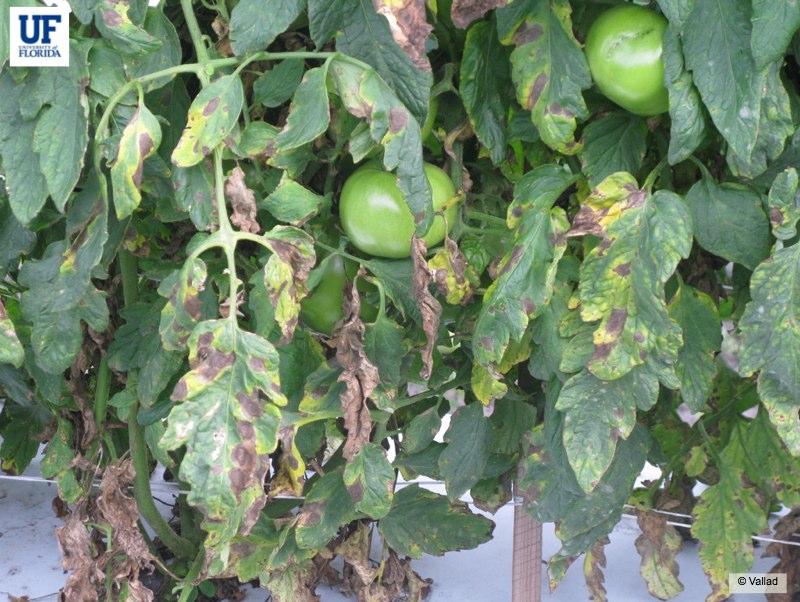
by Blake Thaxton | Apr 21, 2015
With the over abundance of rainfall the western panhandle has seen in recent weeks, tomato gardeners need to be aware of foliar diseases that could appear. Tomato leaves are an ideal host when moisture is present on the leaf surface. There are several of these diseases that, if not managed, can destroy the garden.
Early Blight

Advanced symptoms of Early Blight (Photo Credit: UF/IFAS U-Scout website)
Early Blight is a fungal disease that can affect tomato leaves and fruit. The disease is most prominent when temperatures are 80°F and excess moisture is present from rain or irrigation. The most classic system is the presence of leaf lesions that are approximately 1/2 inch in diameter.
Bacterial Spot
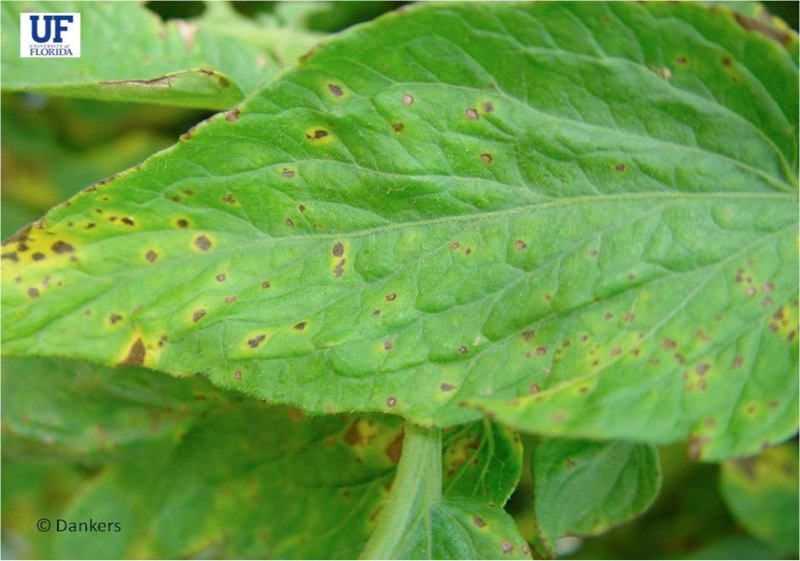
Bacterial Spot on a Tomato leaf (Photo Credit: Hank Dankers, From U-Scout)
Bacterial Spot can also cause problems for Florida tomato gardeners in rainy and high temperature periods. Generally the symptoms are darkened circular lesions on the leaves and fruit. Sometimes bacterial spot can be confused with other leaf lesion diseases. The bacterial spot will ooze when cut where as fungal type lesions will not.
How to prevent foliar diseases in tomato:
- Always start with disease free seed and transplants.
- Irrigate early in the day to minimize the time the leaves stay wet. Use drip irrigation when possible.
- Remove blighted leaves when the garden is dry. This technique should not be relied on exclusively.
- Remove and destroy crop residue at the end of the growing season. If not removed, it can become a breeding ground for disease next year.
- Rotate to different plant families that are not affected by the same diseases.
- Spray protective fungicides such as Mancozeb, Copper, and Chlorothalonil (for example sold as Daconil) when the conditions are right for disease (higher temperatures, excessive moisture, and rainfall).
If you have questions about these diseases or other tomato diseases, please comment below or call your local UF/IFAS Extension Agent.
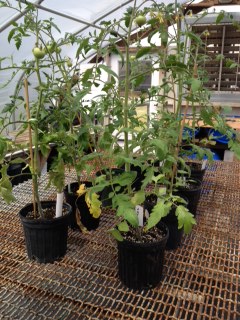
by Eddie Powell | Apr 14, 2015
Growing wholesome, healthy vegetables in a container are a way of life these days. Here are some easy and less expensive tips for creating that bucket garden.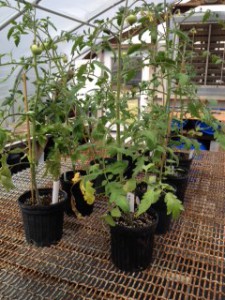
- In a large container or on a plastic mat on the ground, mix garden soil and compost in a 2:1 ratio. Two scoops of soil and one of compost, add the recommended quantity of slow release fertilizer from product label
- Drill 6 to 8- ½ inch holes in the bottom of the 5-gallon buckets. Make sure that the buckets did not contain toxic materials!
- Line the bottom of the bucket with gravel. You may substitute broken pottery or sticks that are broken in short links
- Fill the bucket to within 3 inches of the top of the container
- Place container in sunny spot that will allow drainage
- Plant chosen vegetable with two seeds in center of the container
- Water well and keep moist but not wet
- Place plant support around seeds
Plant requirements:
- Nutrients. Basic needs in plants are Nitrogen (N), Phosphorus (P), Potassium (K). These are listed on all fertilizers as a ratio, example – 8-8-8 contains 8% Nitrogen, 8% Phosphorus, and 8% Potassium and the remaining 76% is a filler. Soils contain many more trace minerals and they are listed on the fertilizer label including directions for use and amounts
- Sunshine or artificial sources of light (grow lights).
- Water. Soil must be kept moist but not wet. Wet soils will create root-rot and encourage fungus. Measure moisture by pinching the soil to see that the soil is moist but never wet. Adding water as needed; plants in hot areas will need much more water than plants in cool spots. Wilted plants need more water!
- Carbon Dioxide (CO2). Plants absorb CO2 and give off Oxygen making them VERY important to human and all animal life.
- Proper Temperatures. Plants will die when it is either too hot or too cold. Make sure that if your plants are outside and the temperature goes below freezing, the plants must be protected or brought inside.
Resources:
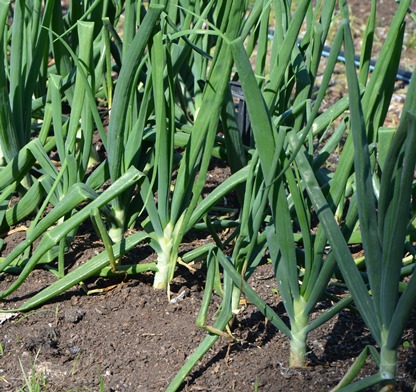
by Les Harrison | Mar 24, 2015

Onions are simple to grow and take up very little space. This is an easy selection for a beginning gardener.
The winter weather is finally giving way to springtime. While temperatures have been erratic, the rain has been sufficient.
There are still plenty of cool season leafy garden crops in production, but they will not last long as the temperatures rise.
One in-ground selection does offer some options. Onions planted last fall provide the greens and the bulb for a nutritional flavor enhancer from salads to a variety of dishes.
The common onion, Allium cepa, has many varieties within the species, and is grown and consumed worldwide. Garlic, chives and leeks are in the same genus as onions with their use similar to onions, but not nearly as frequent.
This popular and simple to grow fall vegetable easily handled the harshest north Florida winters. The multiple mornings of subfreezing temperatures and hard frost had no appreciable effect on this versatile vegetable.
Most regional soils can provide a good growing medium for onions. The lack of sulfur in the dirt and the excellent drainage are two requirements for producing a potentially mild bulb, depending on the cultivar planted.
The high levels of available phosphate in most soils also are an advantage when growing onions.
The Granex yellow onion cultivar is likely the current favorite among many gardeners. This is the same cultivar which produces some the premium branded mild onions on the market today.
Onions can be planted from August to March, either by seed or bulbs. Two inch spacing between plants provide enough space to grow and does not waste limited cultivation area.
Days to harvest depend on how the onion is to be used. Green onions, sometimes known as scallions, take four months with bulb onions taking five months or longer.In reality, onions are biennial but are usually grown as annuals.
Historical evidence of onion usage dates back 7,000 years to the Bronze Age. It is uncertain if these bulbs were cultivated or collected in the wild.
Their ease of transportation, long shelf life, and many uses made them an ideal candidate for long distance travel and trade in the days before refrigeration and high-speed movement of vegetables. Every culture and nation has its own special uses for onions.
Today’s onions provide the consumer with a combination of excellent nutrition, and good storage and handling qualities while enhancing the flavor of many meats, vegetables and salads. The bulbs come in three colors (red, yellow and white) which add to the visual quality of the dining experience.
Onions deliver vitamins B-6, C and Folic Acid. They are naturally low in sodium and fats, and contain four percent sugar.
Onions have compounds such as favonoids and phenolics which have had numerous positive health benefits attributed to them. Their consumption can be part of a healthy diet.
Properly handled onions have a potentially long storage life. Store in a cool, dry, well-ventilated area with 45 to 55 degrees the ideal temperature range.
To learn more about growing onions grown in north Florida, visit your UF/IFAS County Extension office or read the Florida Vegetable Gardening Guide.
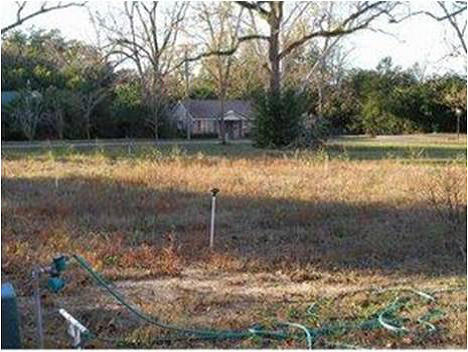
by Eddie Powell | Mar 17, 2015
Site selection of your vegetable garden is a very important part of vegetable gardening because if the appropriate site is not selected than success may be limited.
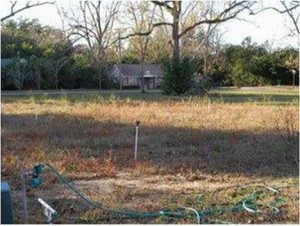
Identify distance between vegetable garden and water source. Image of a Walton County Community Garden site in DeFuniak Springs, FL.
Photo Credit: Eddie Powell
First, the gardener should place the garden in a convenient location near the house so it will be easier to maintain. The garden area also needs to be located near a good water source. Second, the gardener needs to determine how well-drained the soil is in the area and make sure that the soil is not compacted. If it is compacted, tilling will be needed to reduce compaction of the soil and help roots reach out into the soil so that optimal nutrient uptake is ensured. Third, the garden needs to be located in an area that receives at least six hours of direct sunlight daily.
Vegetable plants can be added in the landscape with other ornamental plants with proper care. Garden sites along coastal areas are also suitable places for gardens. It is good, when possible, to rotate the garden from place to place to prevent soil diseases and other pests with specific host species from accumulating in one location. One helpful tip for gardeners is to have a vegetable garden plan drawn out including the names of the plants, their location, and the dates they were planted.
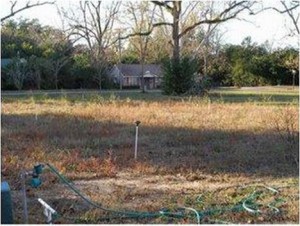
Determine how many hours of sunlight is available to the garden. Image of a Walton County Community Garden site in DeFuniak Springs, FL.
Photo Credit: Eddie Powell
Stop by your local University of Florida IFAS extension office to pick up a Vegetable Gardening Guide. It contains the dates for planting vegetables and maturity timeframes. This guide will also help you decide if you prefer ordering seeds or transplanting bought plants. If using transplants, seeds need to be sowed 4 to 6 weeks before the recommended planting date to allow time for adequate growth before transplanting. The vegetable gardening guide also includes a list of plants that do best as transplants and ones that perform better directly seeded. To learn more on this topic please feel free to stop by your local University of Florida / IFAS Extension office or visit http://edis.ifas.ufl.edu/
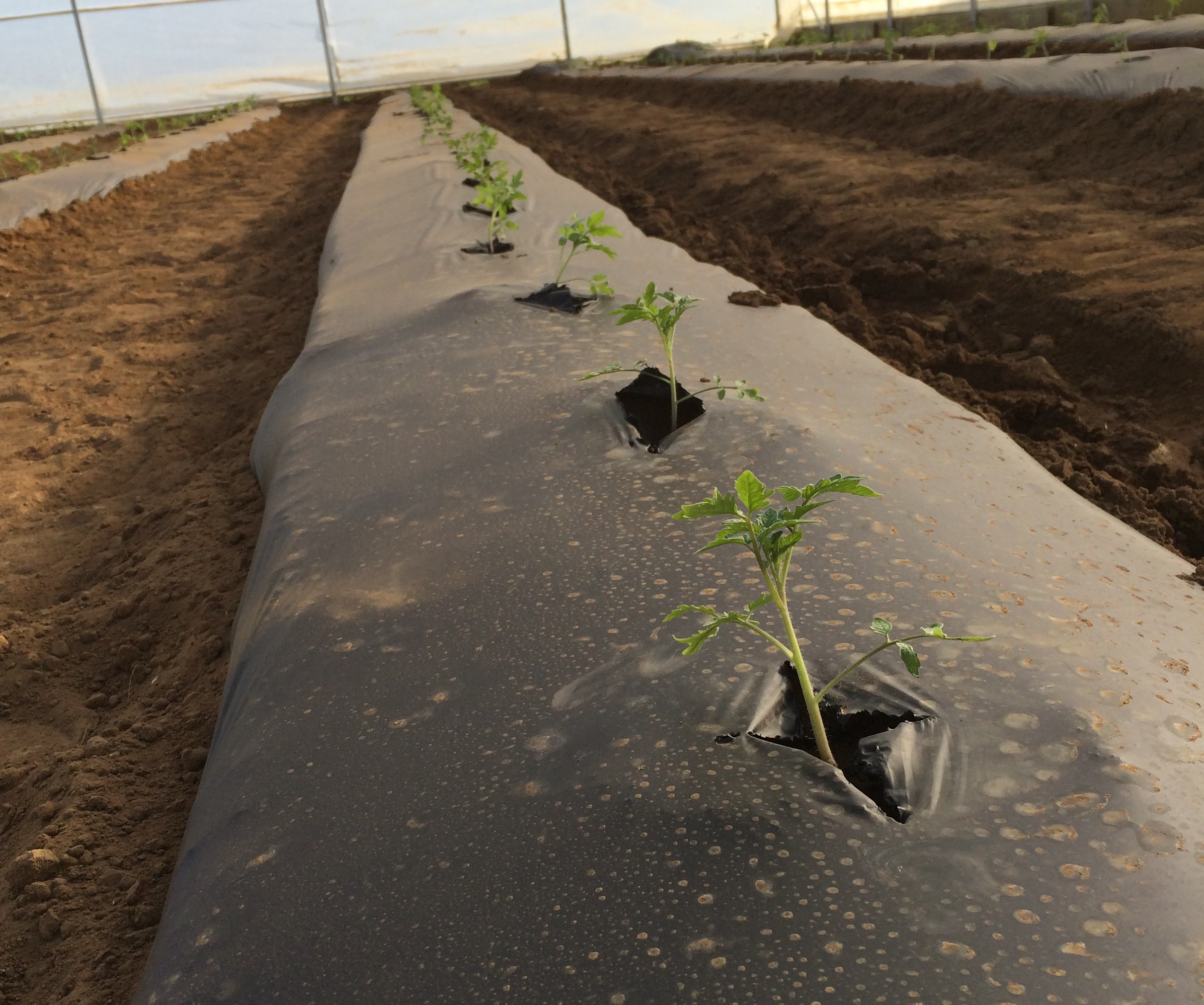
by Blake Thaxton | Jan 27, 2015
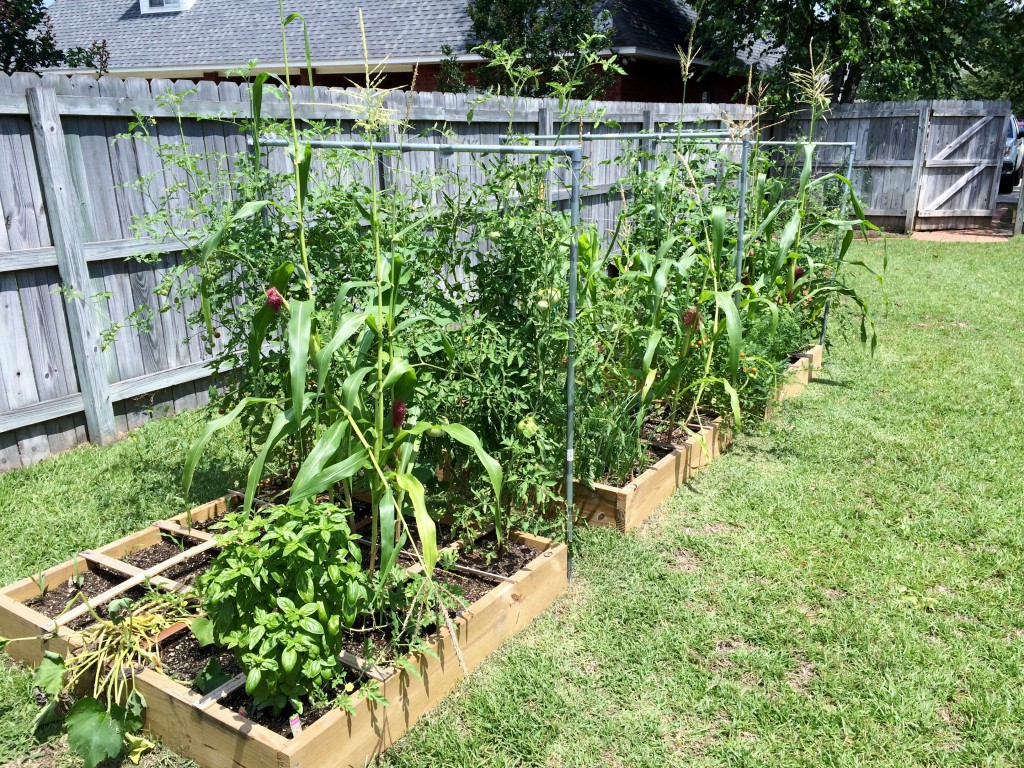
Raised bed spring vegetable garden in NW Florida – photo credit: Blake Thaxton
Growing spring vegetables in northwest Florida can be challenging! Sometimes failures seem more numerous than successes. Extreme cold events in the winter and blistering hot summer days make it tough on vegetables. One suggestion is to get the garden started earlier than usual!
The climate in northwest Florida challenges the gardener due to very high insect pest pressure and it being the perfect environment for fungal and bacterial diseases to grow. Hot and humid summers with moderate winters can be disastrous because diseases will be very active and the insects are not eliminated by extreme cold temperatures. Random cold temperatures in the spring make it hard to know when to plant the vegetable garden.
[important]Because insects and diseases become more active as it gets warmer in the spring, getting a head start may aid the success of your vegetable garden.[/important]
How can a gardener get a head start? Here are a few suggestions:
-
Start Vegetable Transplants Inside
Seems simple, but just getting seed started in a temperature controlled environment can help the vegetable plants get a leg up on the insect pests and diseases that are eminent. If you have a greenhouse structure, that would work perfectly. If not, consider starting your plants in a room with as much possible natural light. On warm days take the plants outside to get some sunshine.
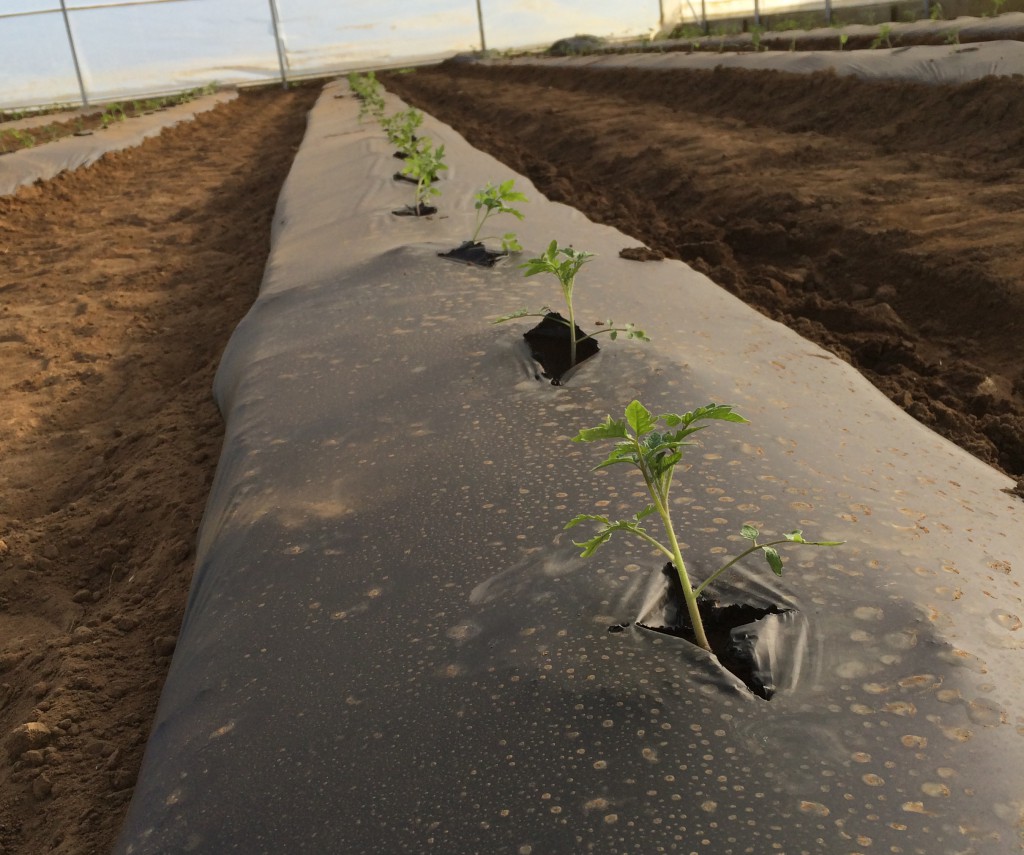
Tomato Plants grown with black plastic mulch – photo credit: Blake Thaxton
Black plastic mulch is commonly used in commercial vegetable production. One of its main functions is to help warm the soil to encourage root growth of the vegetable plants. Other benefits include good moisture and weed control.
Learn more from this Penn State Extension website: Plastic Mulches
Row Covers protect vegetable plants in the ground when temperatures drop lower than expected in the early spring. Row covers are transparent or semitransparent flexible materials used to cover a row of plants to help insulate the air around the plant from the colder temperatures and wind. If you can not find this kind of material you can always use black plastic nursery pots, Styrofoam cups, or other materials to protect individual small plants.
Learn more from this UF/IFAS publication: Row Covers for Growth Enhancement
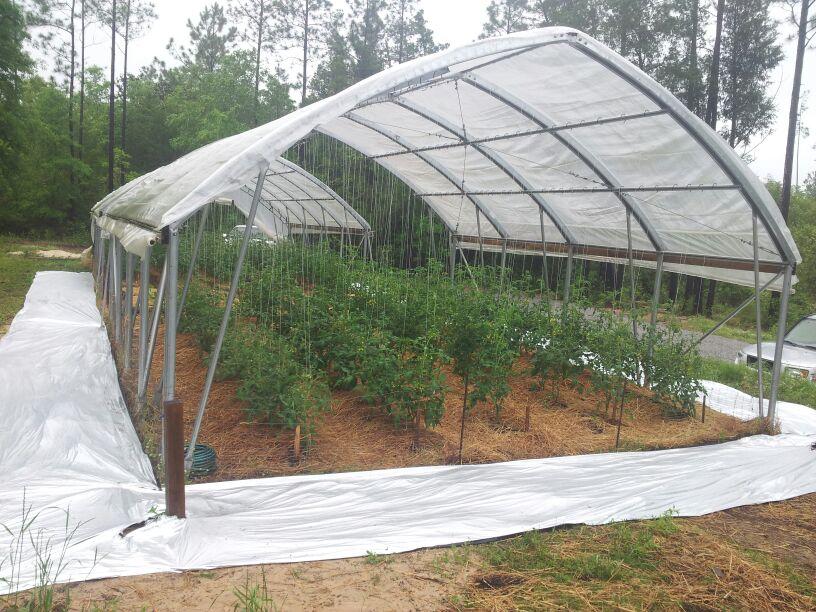
A High Tunnel with end walls and side walls removed for cooling warmer temperatures – photo credit: Blake Thaxton
Another method of protecting your vegetable garden from cold early spring temperatures is to construct a high tunnel, also known as a hoop house. A high tunnel is a structure that looks very much like a greenhouse but the crops are planted in native field soil and the structure lacks an active temperature control. The temperature is passively controlled by rolling up end walls and side walls on warm days and closing the walls when cool temperatures are expected.
Learn how to build a high tunnel from this video from Utah State Extension: How to Build a High Tunnel
For more information on any of these topics please contact your local UF/IFAS Extension Agent or email Blake Thaxton: bthaxton@ufl.edu














